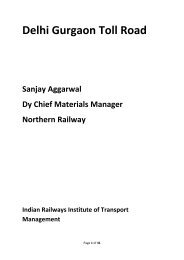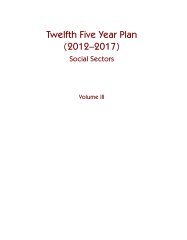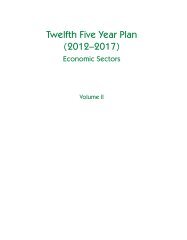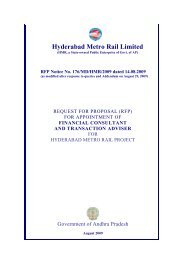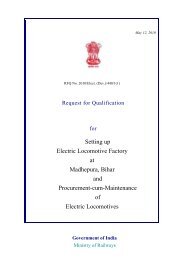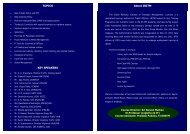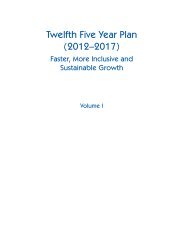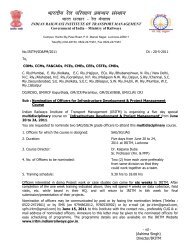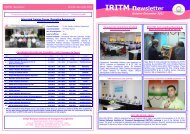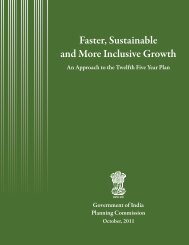Vision 2020 - Transportation Research Group of India
Vision 2020 - Transportation Research Group of India
Vision 2020 - Transportation Research Group of India
Create successful ePaper yourself
Turn your PDF publications into a flip-book with our unique Google optimized e-Paper software.
Government <strong>of</strong> <strong>India</strong><br />
Ministry <strong>of</strong> Railways<br />
(Railway Board)<br />
year to year and anticipated expansion <strong>of</strong> exim trade in agri- produce, it can be assumed that approximately 50<br />
MT <strong>of</strong> food-grains would be loaded by the year <strong>2020</strong> against the present level <strong>of</strong> about 40 MT.<br />
4.1.5 Fertilizer<br />
Fertilizer constitutes approximately 5% <strong>of</strong> the Railway's total traffic, but share <strong>of</strong> rail transport in fertilizer<br />
movement is about 76%. Over the last decade, while indigenous production <strong>of</strong> fertilizers has stagnated, imports<br />
have gone up to bridge the gap. Demand <strong>of</strong> fertilizer is expected to grow in the coming years because <strong>of</strong> the<br />
concerns <strong>of</strong> food scarcity, stress on spreading the Green Revolution to the eastern and southern parts <strong>of</strong> the<br />
country, increased acreage under cultivation and improvement in irrigation facilities. A compounded annual<br />
growth rate <strong>of</strong> 5% in fertilizer demand would be a reasonable assumption and the total fertilizer movement by rail<br />
by <strong>2020</strong>, assuming that the rail-co-efficient remains unchanged, will be 70 MT. Infrastructure at ports will be<br />
crucial for this traffic.<br />
4.1.6 Cement<br />
Growth <strong>of</strong> the cement industry is closely aligned with GDP growth. Cement production has been growing steadily<br />
at the rate <strong>of</strong> 8% per annum and it is expected that by the year <strong>2020</strong> the cement manufacturing capacity in the<br />
country may reach 500 MT, going up from the present level <strong>of</strong> around 230 MT. Presently, Railways carry around<br />
43 % <strong>of</strong> the cement and clinker. Future trends in cement transportation would be marked by a shift to bulk<br />
movement <strong>of</strong> clinker to grinding units, short-radius distribution <strong>of</strong> cement, decline in the movement <strong>of</strong> bagged<br />
cement in favour <strong>of</strong> bulk cement and ready mix concretes. Fly-ash from power plants will also be increasingly<br />
used as a raw material for cement production. It is expected that the rail share in cement/ clinker movement may<br />
rise to 50% (i.e. 250 million tonnes) provided Railways seriously approach the task and prepare themselves to<br />
carry bulk cement. Railway would, however, be under pressure to hold on to their share in bagged cement<br />
movement with the grinding units coming up closer to consumers.<br />
4.1.7 Petroleum<br />
The projected demand <strong>of</strong> petroleum products by 2025 will be 370 million tonnes as per the Hydrocarbon <strong>Vision</strong><br />
2025. It is anticipated that about 45% <strong>of</strong> the POL products will move by pipelines, 26% by rail, 16% by road and<br />
16% by coastal shipping. Petroleum movement by rail in the last 8 years has been growing at a slow average rate<br />
<strong>of</strong> 1.6%. Projected rail movement for POL traffic is estimated to be around 48 MT in the year <strong>2020</strong> (This assumes<br />
that the traffic will grow at an average rate <strong>of</strong> 2% from 38.9 MT in 2008-09).<br />
4.1.8 Container Traffic<br />
With increasing integration with the global economy, our share in world trade will continue to rise steadily from the<br />
present level <strong>of</strong> 1.5%. The present trend <strong>of</strong> increasing containerization <strong>of</strong> cargo will also continue. Maritime<br />
container traffic in <strong>India</strong> is growing at an annual rate <strong>of</strong> nearly 14% compared to the global growth rate <strong>of</strong> 7-8%. Till<br />
2006, container service by rail was operated only by Container Corporation <strong>of</strong> <strong>India</strong> (CONCOR), a public sector<br />
undertaking under the Ministry <strong>of</strong> Railways. In 2006, private operators were permitted and licensed to enter the<br />
container rail business. Many <strong>of</strong> the operators started operations in 2007-08. While CONCOR's business grew<br />
18




